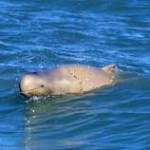 You can hardly have avoided hearing or reading about the proposed Townsville Port expansion, which is part of the massive enlargement of port facilities along the coast (Gladstone and Abbott Point have also received much publicity). While the capital works of the Townsville project pose significant problems, the ongoing operations are expected to be even more damaging. All who care about wildlife and the marine environment need to be concerned.
You can hardly have avoided hearing or reading about the proposed Townsville Port expansion, which is part of the massive enlargement of port facilities along the coast (Gladstone and Abbott Point have also received much publicity). While the capital works of the Townsville project pose significant problems, the ongoing operations are expected to be even more damaging. All who care about wildlife and the marine environment need to be concerned.
Actions and impacts of the project include:
- Deepening of the existing Platypus Channel and deepening and lengthening by 2.7km of the existing Sea Channel.
- Dredging of approximately 9.9 million cubic metres of material from the Cleveland Bay seabed for the initial works and for years into the future.
- Dumping of 5.6 million cubic metres of dredge spoil (in the form of “highly suspendible silt”) in an area midway between Cape Cleveland and Magnetic Island.
- Dumping of remainder (4.3 million cubic meters) on a 100 hectare area of reclaimed land adjacent to the port.
- Increased water turbidity resulting from extension and deepening of shipping channels and from the ongoing maintenance dredging.
- Reactivation and dispersal of ‘historic toxins’ – notably mercury carried down from Charters Towers gold mines well over a century ago – allowing them to enter the food chain.
- Up to twice the number of ships traversing Cleveland Bay, increasing underwater noise and turbidity and heightening the risk of injury to marine fauna, and of accidents or oil spills.
These activities will severely impact on the fringing coral reefs and beaches of Magnetic Island and the seagrass beds in Cleveland Bay and much further afield. The saying that “Hinchinbrook Passage is the true mouth of the Burdekin” reflects the fact that currents flow from the Burdekin at least as far north as Hinchinbrook. The same currents that carry the Burdekin sands and silts will also transport this newly disturbed material. In addition the combination of heavy shipping traffic, noise pollution, siltation, turbidity and smothering of seagrass and corals will place huge stresses on fish nurseries and the populations of dugong, snubfin dolphin (pictured) and turtles – which are already struggling to survive a deadly combination of natural and human-induced changes and stresses.
It is important to note that although the site of the channels, dredging and construction works lie within the GBR World Heritage Area, they are outside the GBR Marine Park – because port areas were specifically excluded from the Park when its boundaries were declared. However the winds and currents carrying the silt know no such boundaries, nor do the turtles, dugong or dolphins. It is inevitable that ecosystems and fauna within the Park will be affected.
A shallow water port is entirely unsuitable for this scale of expansion when it will inflict such damage in World Heritage waters – waters which shelter and sustain some of the iconic species and features of the GBR World Heritage Area. We cannot keep piling stress after stress on wildlife and habitats and expect the ecosystems of our Reef to keep on bouncing back. Resilience is not an inexhaustible or invulnerable quality.
Comments and submissions to the Queensland Government closed on 13 May but the project must also be considered by the Federal Dept of Environment (SEWPAC*) under the EPBC Act*, as it is recognised that there will be “significant impact on matters of national environmental significance”. In addition, any impacts on the GBR Marine Park must be assessed by GBRMPA* which is in a position to refuse dredging/dumping permits.
This means you still have time to be heard – letters and comments to the Federal Government and/or to the GBR Marine Park Authority can be received up to Monday 27 May. Addresses are:
1. For Federal Government : email EIS@townsville-port.com.au or write to: Port of Townsville Limited, c/- Environmental Project Manager (Townsville Port Expansion Project), PO Box 1031, Townsville, Qld 4810.
2. For GBRMPA: email info@gbrmpa@gov.au or write to: Dr Russell Reichelt, Chairman, GBRMPA, PO Box 1379, Townsville, Qld, 4810.
Acronyms used in this post are explained below:
- * SEWPAC – Dept. of Sustainability, Environment, Water, Population and Communities
- * EPBC Act – Environment Protection and Biodversity Conservation Act (1999)
- * GBRMPA – Great Barrier Reef Marine Park Authority




